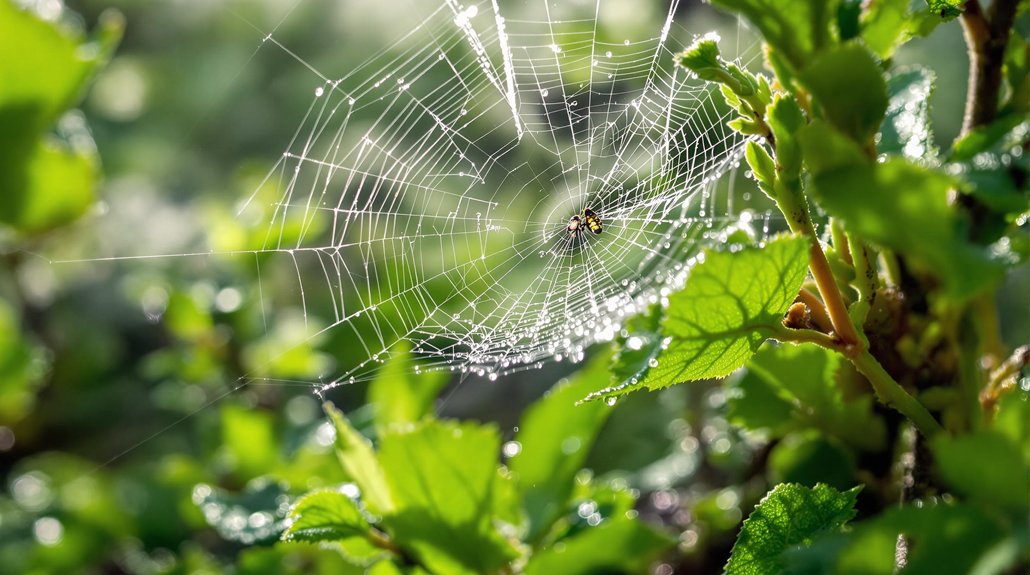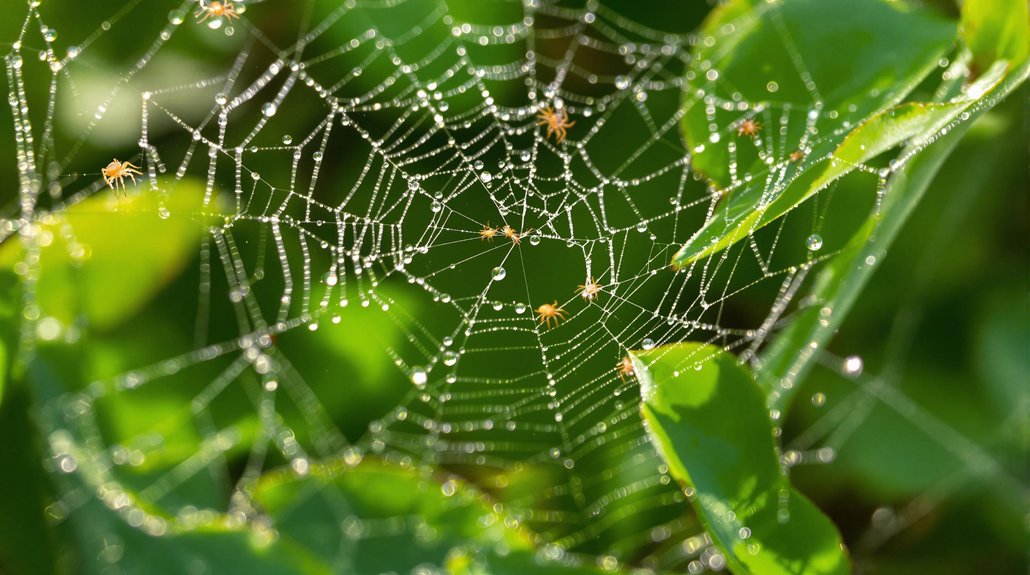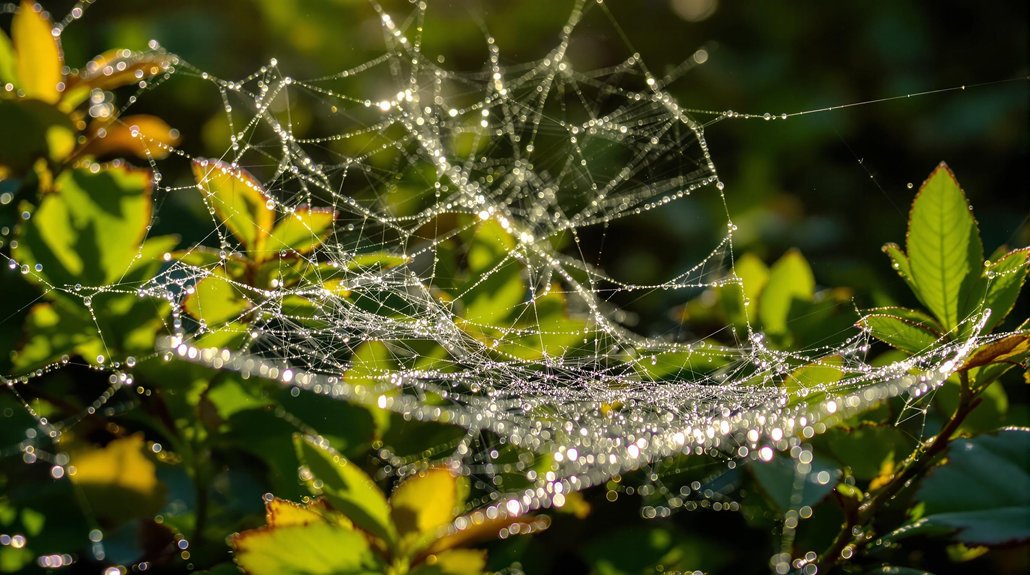Spiders in Clayton, North Carolina, are most active from spring through early fall. Their activity peaks during late summer and early autumn when conditions are warm and humid. During these months, spiders seek shelter, hunt more actively, and build webs. Cooler fall weather triggers some migration and reproduction. Understanding these seasonal patterns can help manage encounters, and the next sections explain how weather and environment influence spider behavior all year round.
Key Article Highlights
- Spiders in Clayton, NC are most active during late summer and early fall, from August to October.
- Spring (March-April) sees increased activity as spiders emerge from overwintering sites.
- Summer (June-July) experiences a surge in spider activity due to breeding and abundant insect prey.
- Humid, warm weather in late spring and summer promotes web-building and hunting behaviors.
- Cooler fall temperatures trigger migration and reproductive behaviors, leading to peak activity in early fall.
Spring Awakening: Spider Activity in March and April

As spring begins in Clayton, North Carolina, spider activity increases noticeably in March and April. During this time, spiders become more visible as they emerge from their overwintering sites. Their habitats vary widely, including leaf litter, shrubs, and corners of buildings. Seasonal behaviors drive this activity, as warmer temperatures trigger mating and the construction of new webs. Spiders often seek out sheltered areas to lay eggs and protect their young. The increase in insect activity also provides more food sources, encouraging spiders to become more active. This period marks a significant change in spider behavior, with many species starting to hunt and reproduce. Understanding these seasonal behaviors helps residents identify when spiders are most active and how they interact with their habitats.
Early Summer Surge: June and July
During June and July, spider activity increases in Clayton, North Carolina. Warmer weather encourages more outdoor movement for both people and spiders. This period also coincides with the spiders’ breeding season, leading to more sightings.
Increased Outdoor Activity
In the early summer months of June and July, outdoor activity among spiders in Clayton, North Carolina, considerably increases. During this time, many outdoor events and activities attract more insects, which serve as food for spiders. As a result, spiders become more active and visible around homes and gardens. Gardeners should consider following specific gardening tips to reduce spider encounters, such as keeping lawns trimmed and removing debris where spiders may hide. Increased outdoor activity also means more chances for spiders to build webs near frequently used areas. Homeowners can take steps to minimize web-building in unwanted spots. Understanding this seasonal pattern helps residents better manage spiders and enjoy outdoor spaces safely during the summer months.
Warm Weather Conditions
Warm weather conditions in early summer, specifically June and July, contribute to a surge in spider activity in Clayton, North Carolina. During this time, rising temperatures create ideal conditions for spider life to thrive. Warm weather influences weather patterns that support spiders’ movement and hunting behavior. As temperatures increase, spiders become more active, seeking food and establishing new webs. The consistent warmth encourages spiders to expand their activity outside of their usual hiding spots. This period marks a peak in spider presence, as they respond to the favorable climate. Understanding how weather patterns impact spider activity helps residents anticipate when spiders are most active. Overall, the warm weather in early summer plays a key role in increasing spider activity in Clayton.
Spiders’ Breeding Season
The early summer months of June and July are the peak breeding period for many spider species in Clayton, North Carolina. During this time, spiders engage in specific breeding behavior and mating rituals to reproduce successfully. Male spiders often seek out females, performing unique courtship displays to attract mates. After mating, females lay eggs in silk cocoons, which they often guard until hatching. This surge in reproductive activity increases the spider population in the area. The table below summarizes key aspects of this breeding season:
| Aspect | Description | Timing |
|---|---|---|
| Mating Rituals | Courtship displays and signals | June and July |
| Egg Laying | Females deposit eggs in cocoons | Late June to July |
| Hatchling Emergence | Spiderlings emerge from cocoons | Late summer |
Late Summer and Early Fall Peaks
Late summer and early fall mark the peak period for spider activity in Clayton, North Carolina. During this time, many spiders engage in spider migration, moving to new locations to find food and suitable habitats. This migration often occurs in late summer when environmental conditions favor movement and survival. Spiders become more visible as they build webs or seek shelter, increasing the likelihood of encounters. The increase in activity is also related to their breeding cycle, which peaks during these months. This period is characterized by a surge in spider populations, making late summer and early fall the busiest time of year for spider movement and activity. Homeowners are more likely to notice spider webs and spiders during this seasonal peak.
The Role of Weather Changes in Spider Behavior

Changes in weather greatly influence spider behavior. Weather patterns, such as temperature and humidity, affect when spiders become active and move. Cooler temperatures in fall often trigger spider migration, prompting them to seek shelter or reproduce. Warm, humid conditions provide ideal environments for spiders to hunt and build webs. Sudden weather changes, like rain or wind, can also cause spiders to hide or relocate.
Key factors include:
- Temperature shifts signal spiders to change activity levels.
- Humidity levels influence web-building and hunting behaviors.
- Weather events like storms can prompt migration or hiding.
Understanding these weather influences helps explain seasonal peaks in spider activity in Clayton, North Carolina. Spiders respond directly to weather patterns, which shape their behavior throughout the year.
Types of Spiders Most Active During Different Seasons
Different types of spiders become most active during specific seasons, influenced by environmental conditions and their life cycles. In Clayton, North Carolina, common local spiders such as orb-weavers and jumping spiders show distinct seasonal behaviors. During spring and summer, orb-weavers are active, building webs to catch insects. Jumping spiders are also frequently seen, hunting during daylight hours. In fall, many spiders, including some wolf spiders, increase activity to prepare for overwintering. Winter generally sees a decline in spider activity, but some species remain sheltered indoors. Seasonal spider behaviors are driven by temperature, humidity, and prey availability. Understanding these patterns helps identify when certain spiders are most likely to be encountered, providing insight into their life cycles and activity periods throughout the year.
How Temperature Influences Spider Movements
Temperature plays a significant role in how spiders move and behave throughout the year. Variations in temperature directly affect spider activity levels and movement patterns. When temperatures are warm, spiders tend to be more active, searching for food and mates. Conversely, cooler temperatures often lead to decreased activity or dormancy.
Key factors include:
- Temperature fluctuations influence when spiders emerge from hiding or become dormant.
- Higher temperatures stimulate increased movement and web-building behavior.
- Lower temperatures cause spiders to reduce activity, often seeking shelter to survive the cold.
Understanding these patterns helps explain seasonal changes in spider activity. Temperature variations are essential in predicting spider behavior and their most active periods in Clayton, North Carolina.
Humidity and Its Impact on Spider Activity

When humidity levels increase, spiders tend to seek out more moisture. This change can lead to more web-building activity as they find suitable places. Higher humidity often results in more spider movement and activity.
Humidity Levels Rise
As humidity levels increase, spider activity tends to rise. Higher humidity creates ideal conditions aligned with their humidity preferences, encouraging more movement and hunting. Increased moisture attraction draws spiders to areas with higher moisture content, such as corners, basements, or outdoor vegetation.
- Spiders seek environments with ample moisture, which supports their physiological needs.
- Elevated humidity makes their prey more active, indirectly boosting spider activity.
- Moist conditions help spiders build and maintain their webs more effectively.
Understanding this connection helps explain seasonal activity patterns. When humidity rises, spiders become more active, especially in late spring and summer. Recognizing these environmental cues is essential for those studying spider behavior or managing pests in Clayton, North Carolina.
Spiders Seek Moisture
Increased humidity levels directly influence where spiders choose to live and hunt. Spiders seek moisture sources to stay hydrated and support their daily activities. Areas with high humidity provide ideal conditions for maintaining their bodies and for finding prey. These moisture sources often include damp basements, leaf litter, and shaded outdoor spaces. As a result, spider habitats are more likely to be found in moist environments during periods of high humidity. When moisture is abundant, spiders are more active because they can easily access water and hunt effectively. Conversely, dry conditions tend to limit their activity and restrict their habitats to the few remaining moist spots. Understanding this relationship helps explain seasonal patterns of spider activity in Clayton, North Carolina.
Increased Web Building
Higher humidity levels often lead to increased web-building activity in spiders. Moist conditions help spiders improve their web construction techniques, making their webs more effective at catching prey. When humidity is high, spiders tend to build larger and more intricate webs to maximize their chances of survival. This behavior aligns with seasonal prey availability, as insects are more active in humid environments.
- Spiders adapt their web design to capture more prey during humid periods.
- Elevated humidity encourages the production of stronger silk for web durability.
- Increased web-building is a strategic response to seasonal prey abundance.
Preparing Your Home for Seasonal Spider Activity
With seasonal changes bringing more spider activity, homeowners should take steps to prepare their residences. One effective method is implementing spider proofing techniques, such as sealing cracks and gaps around windows, doors, and the foundation. These small openings can serve as entry points for spiders seeking shelter. Additionally, seasonal cleaning helps reduce hiding spots by removing clutter, webs, and debris from both indoor and outdoor areas. Regularly vacuuming corners, baseboards, and storage spaces prevents spiders from establishing nests. Landscaping adjustments, like trimming bushes and removing leaf piles near the house, also limit spider access. Proper preparation creates a less inviting environment for spiders, reducing the likelihood of infestations during peak seasons. These proactive steps are essential for maintaining a clean and spider-free home.
Tips for Managing Spiders During Peak Seasons
During peak seasons of spider activity, homeowners can take specific steps to manage and reduce their presence. Using effective spider deterrents and natural repellents can help keep spiders away.
- Seal cracks and gaps around windows, doors, and foundations to prevent entry.
- Use natural repellents like essential oils (peppermint, tea tree) or vinegar solutions around entry points and dark corners.
- Keep outdoor areas tidy by removing clutter, leaves, and debris where spiders may hide.
Regularly cleaning and vacuuming corners, basements, and attics also reduces hiding spots. These simple measures help homeowners control spider populations during their most active times. Incorporating natural repellents and sealing strategies guarantees a safer, less inviting environment for spiders.





